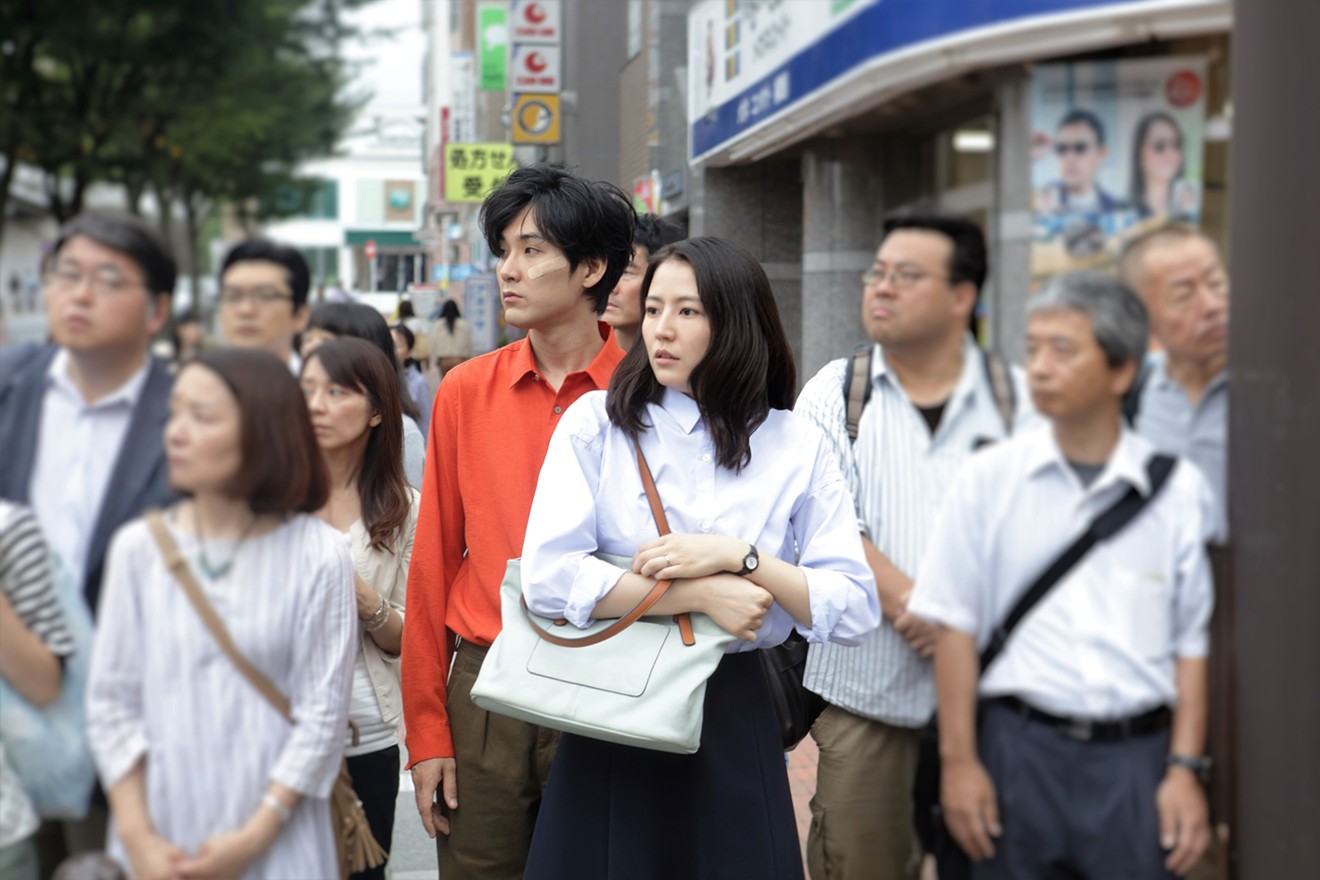iIf there’s one thing the Japanese genre filmmakers whose work turns up at U.S. festivals tend to nail, it’s masterfully creating a sense of inescapable existentialist dread. At this year’s Fantastic Fest, two films bummed me out beautifully — a nice distraction from the ugly bum-out of the all the festival’s controversy.
Kiyoshi Kurosawa’s Before We Vanish is like a more sensitive, thoughtful take on Invasion of the Body Snatchers, with an alien species suddenly inhabiting the bodies of three unlucky souls — handsome young guy Amano (Mahiro Takasugi), unfaithful husband Shinji (Ryuhei Matsuda) and schoolgirl Akira (Yuri Tsunematsu). These aliens then steal people’s conceptions — like their ideas of family, of work, or the self — in order to understand the human race and ultimately destroy it.
Kurosawa opens on a shot of a hand roaming over a bowl of goldfish, then plucking one out and into an empty plasticbag; watching fish floundering out of water puts me on edge. Kurosawa doesn’t let up with the tension in the minutes that follow, but he does ratchet up the dark humor. We see sweet-faced Akira walking home with the gold fish. She steps inside and closes the door. A few seconds later, an older woman tries to escape out that door, only to be dragged back into the house. Then we see Akira, inside, smiling and inspecting the blood on her fingers and clothes, before Kurosawa quickly cuts away to a vision of her strolling happily down the center of a busy street, leaving chaos and destruction behind her. That thrilling opening is only about four minutes long but opens up a million questions.
Kurosawa dribbles out information as we need it, but these introductions to people are so strange and compelling that I didn’t don’t care why or how all this was happening. All I needed was to watch it unfold. We meet Shinji in a med clinic waiting room, getting chewed out by his wife for not knowing who she is. A moment later, he’s trying to walk to her car and loses control of his legs, then tries to drag himself along a fence, lazily thrashing on the ground — what the fuck is happening? While these bits are fascinating fun, Kurosawa uses the aliens’ ability to steal conceptions as a means to explore deeper topics, like what exactly makes humans human. Is it language? The ability to communicate? To love? If you no longer possess an understanding of love, is existence meaningless? Ah, there’s the dread I was looking for. In one scene, a cynical journalist with knowledge of the aliens’ plot jumps up on a table and tries to convince people that the body-snatched child standing nearby is trying to kill them, only to be met with confused stares. Welp, at least he tried.
In Yoshio Kato’s 3ft Ball & Souls, all we get is characters trying and trying in vain to convince someone of something. The “someone” who needs convincing is a pretty schoolgirl who wants to take her own life. The problem is that the convincers are a trio of adults who also want to commit suicide, and every hypocritical argument they throw at her about preserving her life fuels her desire to go ahead and push the little red button on a three-foot-wide ball of fireworks situated among them in a tiny metal shack. Boom.
There’s good news, and there’s bad news for this crew. The good news is that the quartet continually comes back to life, reliving the same moments like Groundhog Day in miniature. The bad news is that the girl is the only character who remembers nothing. This low-budget charmer has a dark premise but fills its confined space with humor, as each character grows more and more frustrated by the situation: they must forever endure the same death at the hands of this child. In the first lived life, the schoolgirl rushes to touch the three-foot ball, and the elder gentleman of the group asks her not to. By the third, he’s screaming at her not to touch the damn ball the second she opens the doors.
The trajectory of this story is obvious too early, though. In convincing the girl not to take her life, the three adults will realize there’s a reason for themselves to live. Those scenes don’t play as effective as the comic ones, but for a film that was shot for a pittance almost entirely in the director’s grandmother’s backyard shed, Kato manages to deliver a funny, thoughtful, sincere message.
[
{
"name": "Air - MediumRectangle - Inline Content - Mobile Display Size",
"component": "12017618",
"insertPoint": "2",
"requiredCountToDisplay": "2"
},{
"name": "Editor Picks",
"component": "17242653",
"insertPoint": "4",
"requiredCountToDisplay": "1"
},{
"name": "Inline Links",
"component": "18838239",
"insertPoint": "8th",
"startingPoint": 8,
"requiredCountToDisplay": "7",
"maxInsertions": 25
},{
"name": "Air - MediumRectangle - Combo - Inline Content",
"component": "17261320",
"insertPoint": "8th",
"startingPoint": 8,
"requiredCountToDisplay": "7",
"maxInsertions": 25
},{
"name": "Inline Links",
"component": "18838239",
"insertPoint": "8th",
"startingPoint": 12,
"requiredCountToDisplay": "11",
"maxInsertions": 25
},{
"name": "Air - Leaderboard Tower - Combo - Inline Content",
"component": "17261321",
"insertPoint": "8th",
"startingPoint": 12,
"requiredCountToDisplay": "11",
"maxInsertions": 25
}
]











